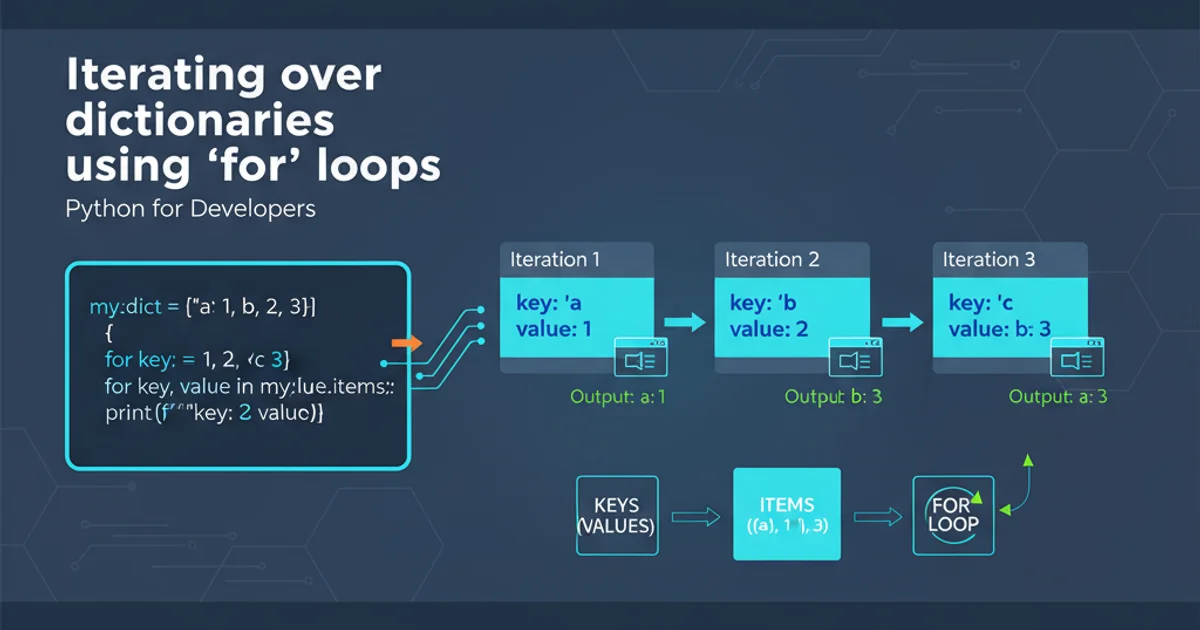Iterating over dictionaries using 'for' loops
Categories:
Mastering Dictionary Iteration with 'for' Loops in Python

Unlock the full potential of Python dictionaries by learning various methods to iterate through their keys, values, and key-value pairs using 'for' loops.
Dictionaries are fundamental data structures in Python, offering a flexible way to store data in key-value pairs. Efficiently accessing and processing this data often involves iterating over the dictionary's contents. Python's for loop provides several straightforward and powerful ways to achieve this, whether you need just the keys, just the values, or both.
Iterating Over Keys (Default Behavior)
When you iterate over a dictionary directly using a for loop, Python's default behavior is to iterate over its keys. This is the most common and often the most efficient way to access dictionary elements if your primary need is to work with the keys themselves, or to use the keys to look up their corresponding values.
my_dict = {
"name": "Alice",
"age": 30,
"city": "New York"
}
print("Iterating directly (over keys):")
for key in my_dict:
print(f"Key: {key}, Value: {my_dict[key]}")
print("\nUsing .keys() explicitly:")
for key in my_dict.keys():
print(f"Key: {key}, Value: {my_dict[key]}")
Iterating over dictionary keys using default behavior and the .keys() method.
for key in my_dict: is syntactically cleaner and often preferred, for key in my_dict.keys(): explicitly states your intention to iterate over keys, which can improve readability for some developers.Iterating Over Values
Sometimes, you only need to process the values stored within a dictionary, without needing access to their associated keys. Python provides the .values() method for this purpose, which returns a view object that displays a list of all the values in the dictionary. This is particularly useful when performing operations that only depend on the data values themselves.
my_dict = {
"item1": 100,
"item2": 250,
"item3": 120
}
total_value = 0
print("Iterating over values:")
for value in my_dict.values():
print(f"Processing value: {value}")
total_value += value
print(f"\nTotal sum of values: {total_value}")
Calculating the sum of dictionary values by iterating using .values().
Iterating Over Key-Value Pairs
The most comprehensive way to iterate over a dictionary is to access both the key and its corresponding value simultaneously. The .items() method returns a view object that displays a list of a dictionary's key-value tuple pairs. This is ideal when you need to perform operations that involve both pieces of information for each entry.
my_dict = {
"product_id": "P101",
"product_name": "Laptop",
"price": 1200.00,
"in_stock": True
}
print("Iterating over key-value pairs:")
for key, value in my_dict.items():
print(f"Key: {key}, Value: {value}")
# Example: Filtering based on value
print("\nFiltering for boolean values:")
for k, v in my_dict.items():
if isinstance(v, bool):
print(f"Boolean field found: {k} = {v}")
Accessing both keys and values using the .items() method.
flowchart TD
A[Start Iteration] --> B{Choose Iteration Method}
B -->|Need Keys Only?| C[for key in dict:]
B -->|Need Values Only?| D[for value in dict.values():]
B -->|Need Key & Value?| E[for key, value in dict.items():]
C --> F[Process Key]
D --> G[Process Value]
E --> H[Process Key & Value]
F --> I{More Items?}
G --> I
H --> I
I -->|Yes| B
I -->|No| J[End Iteration]Decision flow for choosing the correct dictionary iteration method.
.keys(), .values(), and .items() are dynamic. This means if the dictionary changes after the view object is created, the view object reflects these changes.